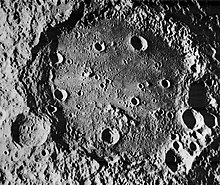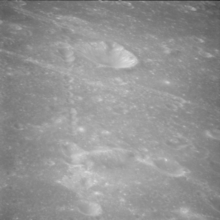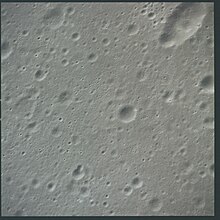Mendeleev (crater)
 | |
| Coordinates | 5°42′N 140°54′E / 5.7°N 140.9°E |
|---|---|
| Diameter | 313 km |
| Colongitude | 224° at sunrise |
| Eponym | Dmitri Mendeleev |


Mendeleev is a large lunar impact crater that is located on the far side of the Moon, as seen from the Earth. The southern rim of this walled plain just crosses the lunar equator. Intruding into the eastern rim of Mendeleev is the crater Schuster. Nearly on the opposite side, the smaller Hartmann intrudes into west-southwestern rim.
The crater is named after the Russian chemist Dmitri Mendeleev. Even after formal naming in 1961 by the IAU,[1] the crater was known as Basin IX until the early 1970s.[2]
Mendeleev is a basin of Nectarian age.[3] The interior plains of Mendeleev are covered with deposits of the Cayley Formation of Imbrian age.[4]

Description
[edit]The nearly level interior of Mendeleev contains a number of smaller crater formations which have been given names. These form a rough pentagon formation that covers much of the interior floor. Along the western inner floor, the craters Bergman to the west-northwest and Moissan to the west just make contact with the western inner wall of Mendeleev. Together with Bergman, Fischer to the north-northeast and Richards in the north of Mendeleev form the northern side of the pentagon. The figure continues with Harden near Schuster, and Benedict just to the southeast of the midpoint of Mendeleev. The largest crater within the Mendeleev basin is Mendeleev P, to the south-southwest.
The remainder of the interior floor is relatively flat, at least in comparison to the rugged blast terrain radiating away from the exterior. There are, however, a number of small craters within the interior in addition to those mentioned above. A cluster of these craters lie near the midpoint of the interior, and there are several in the southeast part of the floor. In the western half of the floor is a chain of tiny craters named the Catena Mendeleev. These form a line that trends from near the southwest part of the interior, then tangentially grazes the western rim of the crater Richards. The line of craters points directly to Tsiolkovskiy crater far to the southwest, and are thought to be secondaries from it.[5]
In fiction
[edit]In Stanislaw Lem's More Tales of Pirx the Pilot, a story is wrapped around a fictional lunar science facility that is stationed in Mendeleev.
Satellite craters
[edit]By convention these features are identified on lunar maps by placing the letter on the side of the crater midpoint that is closest to Mendeleev. In this case, the only satellite crater is Mendeleev P, which lies within southern Mendeleev itself.
| Mendeleev | Latitude | Longitude | Diameter |
|---|---|---|---|
| P | 2.7° N | 139.4° E | 29 km |
References
[edit]- ^ Mendeleev, Gazetteer of Planetary Nomenclature, International Astronomical Union (IAU) Working Group for Planetary System Nomenclature (WGPSN)
- ^ Lunar Farside Chart (LFC-1A)
- ^ The geologic history of the Moon. USGS Professional Paper 1348. By Don E. Wilhelms, John F. McCauley, and Newell J. Trask. U.S. Government Printing Office, Washington: 1987. Table 9-3.
- ^ Apollo 16 Preliminary Science Report, NASA Special Publication 315, 1972. Chapter 28.
- ^ The geologic history of the Moon, 1987, Wilhelms, Don E.; with sections by McCauley, John F.; Trask, Newell J. USGS Professional Paper: 1348. Figure 9.26 B (online)
- Andersson, L. E.; Whitaker, E. A. (1982). NASA Catalogue of Lunar Nomenclature. NASA RP-1097.
- Bussey, B.; Spudis, P. (2004). The Clementine Atlas of the Moon. New York: Cambridge University Press. ISBN 978-0-521-81528-4.
- Cocks, Elijah E.; Cocks, Josiah C. (1995). Who's Who on the Moon: A Biographical Dictionary of Lunar Nomenclature. Tudor Publishers. ISBN 978-0-936389-27-1.
- McDowell, Jonathan (July 15, 2007). "Lunar Nomenclature". Jonathan's Space Report. Retrieved 2007-10-24.
- Menzel, D. H.; Minnaert, M.; Levin, B.; Dollfus, A.; Bell, B. (1971). "Report on Lunar Nomenclature by the Working Group of Commission 17 of the IAU". Space Science Reviews. 12 (2): 136–186. Bibcode:1971SSRv...12..136M. doi:10.1007/BF00171763. S2CID 122125855.
- Moore, Patrick (2001). On the Moon. Sterling Publishing Co. ISBN 978-0-304-35469-6.
- Price, Fred W. (1988). The Moon Observer's Handbook. Cambridge University Press. ISBN 978-0-521-33500-3.
- Rükl, Antonín (1990). Atlas of the Moon. Kalmbach Books. ISBN 978-0-913135-17-4.
- Webb, Rev. T. W. (1962). Celestial Objects for Common Telescopes (6th revised ed.). Dover. ISBN 978-0-486-20917-3.
- Whitaker, Ewen A. (1999). Mapping and Naming the Moon. Cambridge University Press. ISBN 978-0-521-62248-6.
- Wlasuk, Peter T. (2000). Observing the Moon. Springer. ISBN 978-1-85233-193-1.
External links
[edit]- Mendeleev at the Moon Wiki
- Catena Mendeleev at the Moon Wiki
- "Crater Mendeleev", Lunar Reconnaissance Orbiter, NASA, February 3, 2011, retrieved 2012-03-27 – mosaic image of the Mendeleev crater from the LROC WAC.
- Inside Catena Meldeleev - Lunar Reconnaissance Orbiter on Catena Mendeleev
- LAC-66, chart of Mendeleev and surrounding terrain
Related article
[edit]- Wood, Chuck (August 15, 2004). "A Chain of Evidence". Lunar Photo of the Day., on Catena Mendeleev
Text is available under the CC BY-SA 4.0 license; additional terms may apply.
Images, videos and audio are available under their respective licenses.
